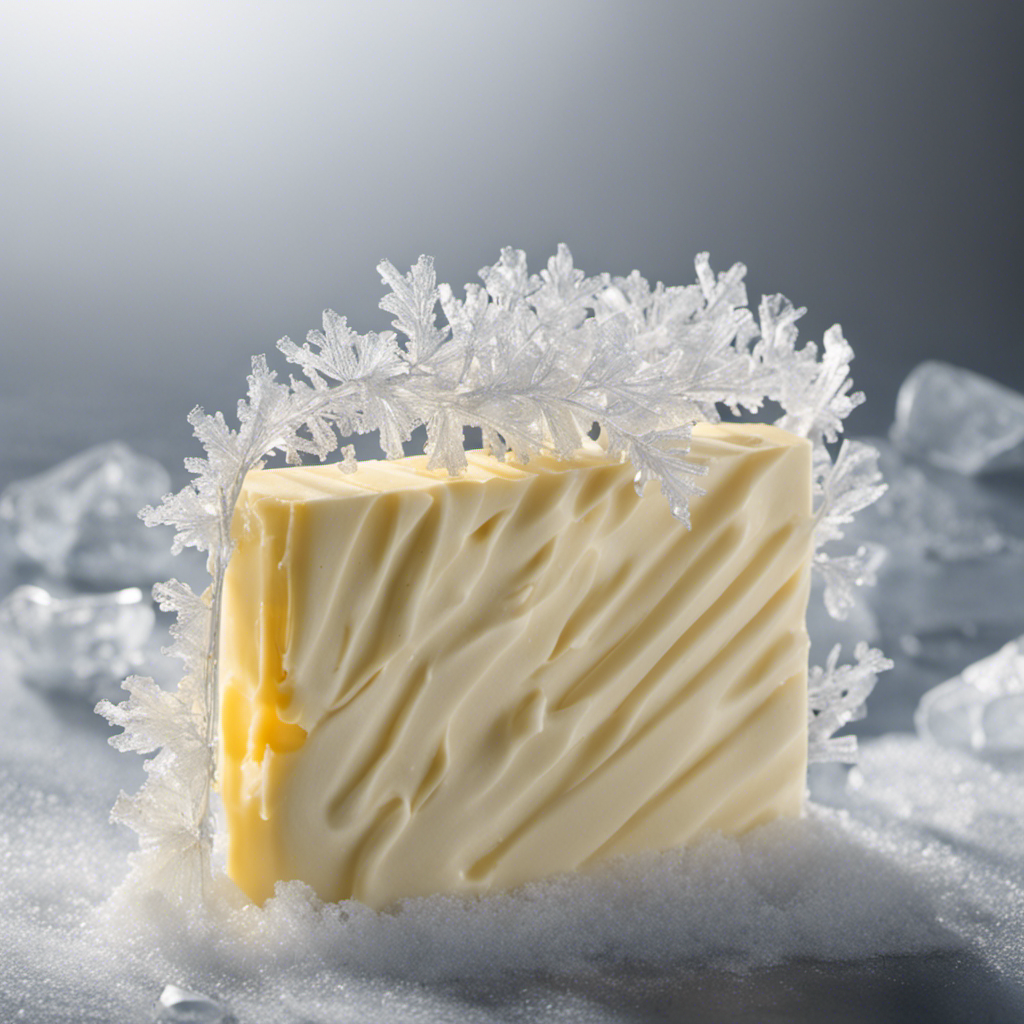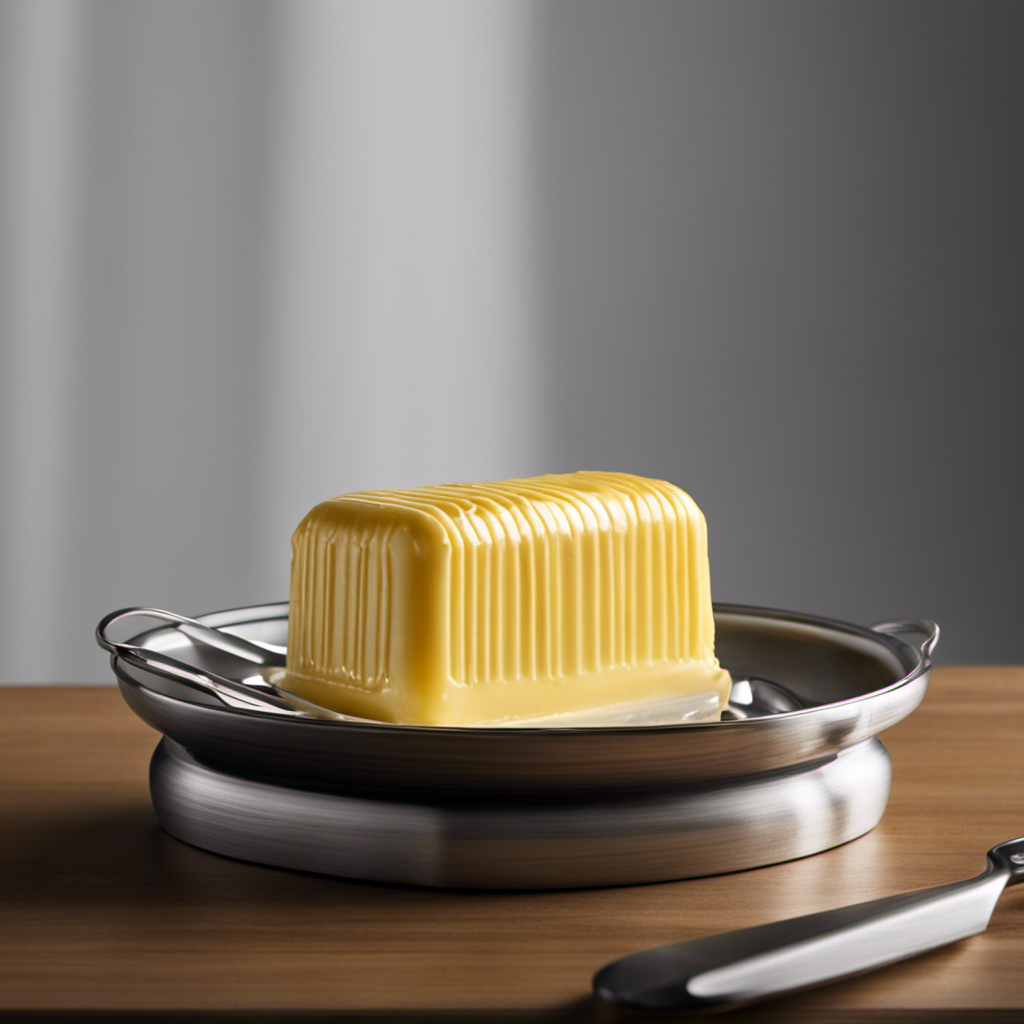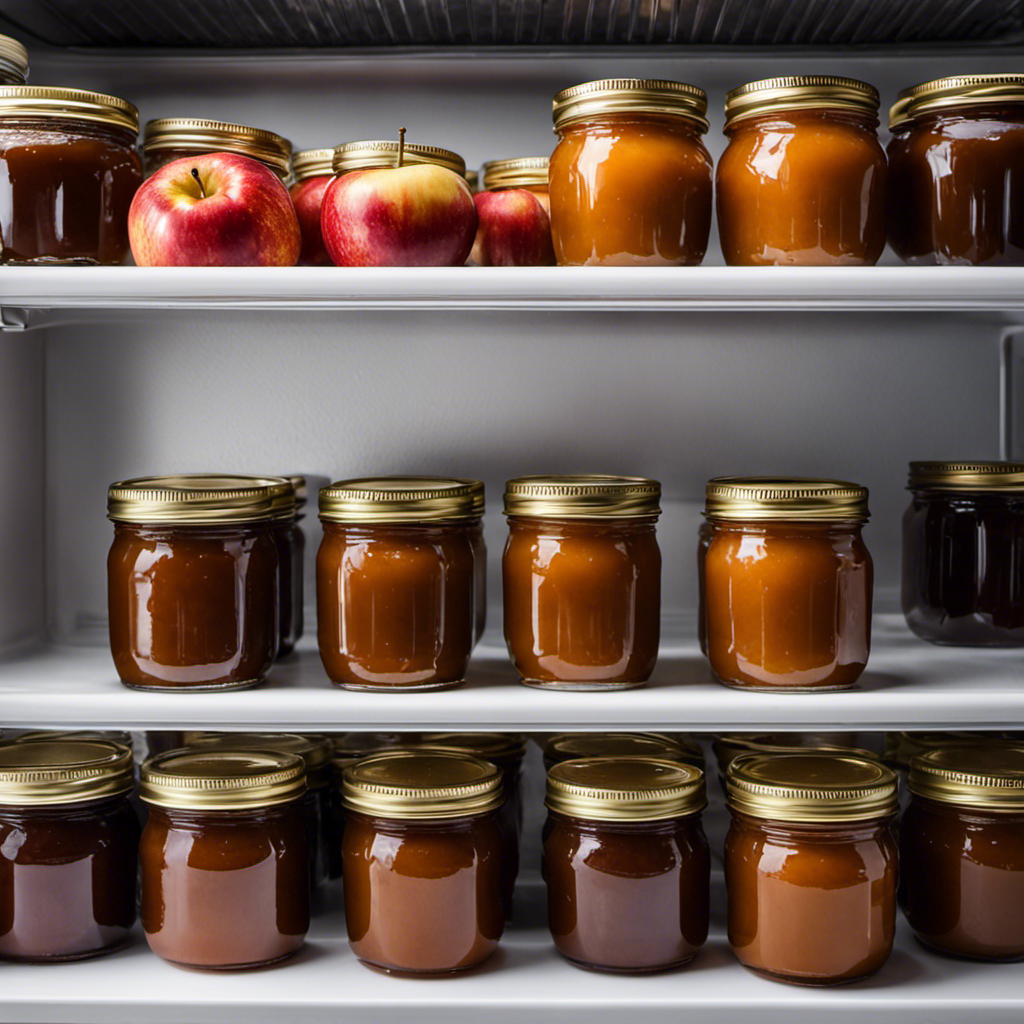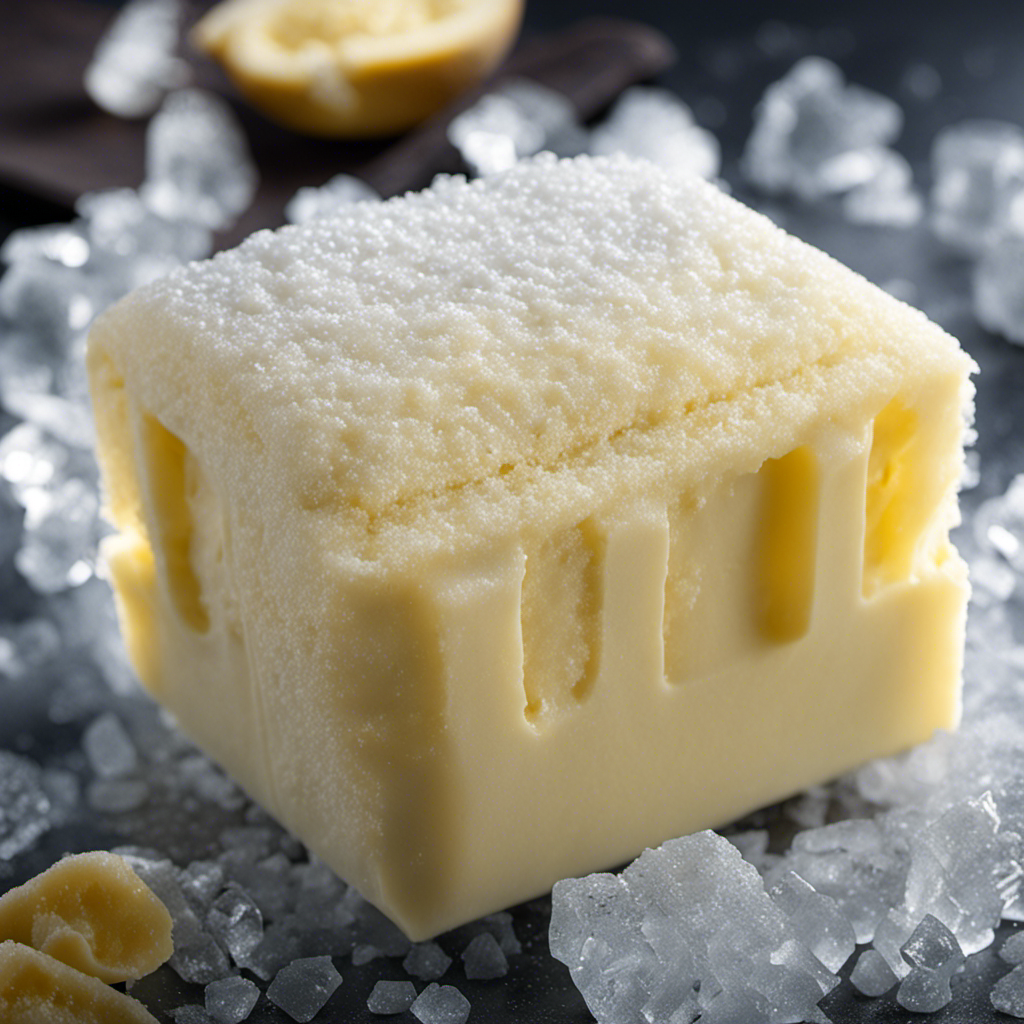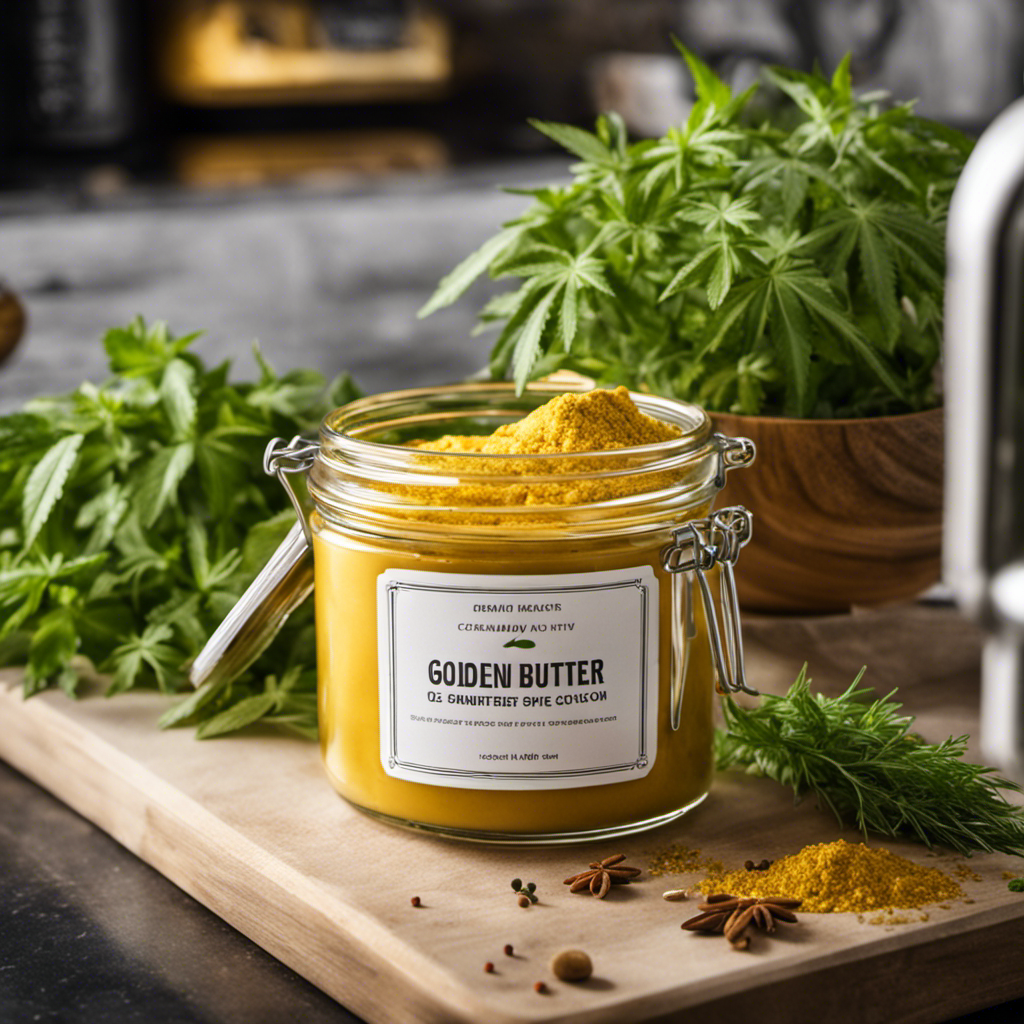As I excitedly put the stick of butter in the freezer, I couldn’t help but ponder: how long will it take to solidify?
The answer to this question depends on various factors, such as the temperature of the freezer and the size of the butter.
In this article, we will explore the science behind freezing butter and provide you with the recommended freezing times for both sticks and blocks.
Join me on this freezing journey as we unravel the mysteries of preserving butter’s delightful taste and texture.
Key Takeaways
- The freezing time of butter can be affected by factors such as the fat content, temperature of storage, form of butter, and size of butter portion.
- Proper preparation for freezing butter includes cutting it into sticks, wrapping each stick tightly in plastic wrap or aluminum foil, and placing them in a freezer-safe container or bag.
- Butter sticks should be frozen for a maximum of six months at a temperature of 0°F or below, using airtight packaging or freezer bags to prevent moisture loss and freezer burn.
- For butter blocks or cubes, the ideal freezing temperature is around 0°F, and shelf life after freezing can vary depending on the packaging used. Thawing should be done slowly in the refrigerator or using the defrost setting on a microwave.
Factors Affecting Freezing Time
There are several factors that can affect how long it takes to freeze butter.
One of the main factors affecting the freezing time is the quality of the butter. Butter with a higher fat content tends to freeze more slowly compared to butter with a lower fat content.
Another factor is the temperature at which the butter is stored. The lower the temperature, the faster the butter will freeze.
Additionally, the form of the butter can also impact the freezing time. Whipped butter, for example, freezes faster than solid butter due to its increased surface area.
Lastly, the size of the butter portion can affect the freezing time as well. Smaller portions freeze faster compared to larger portions.
Understanding these factors can help determine the optimal conditions for freezing butter.
Proper Preparation for Freezing Butter
When preparing to freeze butter, it’s important to follow the proper steps. Here are four key steps to ensure your butter freezes well:
-
Cut the butter into sticks: Before freezing, it’s best to cut the butter into individual sticks. This allows for easier portioning and thawing later on.
-
Wrap the butter tightly: To prevent freezer burn and maintain freshness, wrap each stick of butter tightly in plastic wrap or aluminum foil. Make sure there are no air pockets.
-
Place in a freezer-safe container: Transfer the wrapped butter sticks into a freezer-safe container or resealable plastic bag. This further protects the butter from absorbing any odors or moisture from the freezer.
-
Label and date: Lastly, don’t forget to label the container or bag with the current date. This will help you keep track of when the butter was frozen and ensure you use it before it loses its quality.
Recommended Freezing Time for Butter Sticks
To ensure optimal quality, it’s recommended that you freeze your butter sticks for a maximum of six months. Freezing butter is a great way to extend its shelf life and maintain its freshness. However, it’s important to store it at the recommended storage temperature of 0°F or below.
Improper freezing can lead to changes in texture and flavor. Inadequate packaging or exposure to air can cause the butter to develop freezer burn, resulting in a dry and off-tasting product. It’s essential to wrap the butter tightly in airtight packaging or use freezer bags to prevent moisture loss.
By following these guidelines, you can enjoy your frozen butter sticks for up to six months while maintaining their quality.
Now let’s discuss the freezing time for butter blocks or cubes.
Freezing Time for Butter Blocks or Cubes
When it comes to freezing butter blocks or cubes, there are a few key points to consider.
Firstly, the ideal freezing temperature for butter is around 0°F (-18°C). This low temperature helps to preserve the quality and flavor of the butter during freezing.
Secondly, the shelf life after freezing can vary depending on the packaging used. Vacuum-sealed packaging or airtight containers can help extend the shelf life of frozen butter by preventing freezer burn and oxidation.
Lastly, when choosing the best packaging for freezing butter, it is important to consider options that are moisture-resistant and durable to ensure proper protection during storage.
Ideal Freezing Temperature
The ideal temperature for freezing butter is below 32 degrees Fahrenheit. Freezing butter can be beneficial in preserving its freshness and extending its shelf life. However, there are also some drawbacks to consider.
Here are some benefits of freezing butter:
- Keeps the butter fresh and prevents it from spoiling.
- Extends the shelf life of butter, allowing you to use it for a longer period.
- Preserves the flavor and texture of butter.
- Convenient for storing excess butter or bulk purchases.
On the other hand, there are also drawbacks to freezing butter:
- Freezing can affect the texture of butter, making it slightly grainy or crumbly.
- Thawing and re-freezing butter multiple times can diminish its quality.
- Takes time for the butter to thaw before use.
If you’re looking for alternative methods of preserving butter, here are a few options:
- Storing butter in an airtight container in the refrigerator can keep it fresh for a few weeks.
- Clarifying butter by removing the milk solids can extend its shelf life.
- Canning butter in sterilized jars can preserve it for a longer period without refrigeration.
- Making compound butter by mixing it with herbs or spices can enhance its flavor and increase its shelf life.
Shelf Life After Freezing
If you freeze it properly, you can extend the shelf life of your butter. Freezing butter can help preserve its quality and prevent it from going bad. When stored in the freezer at a temperature of 0°F (-18°C) or below, butter can last for up to 9-12 months.
However, it is important to note that while freezing can prolong the shelf life of butter, it may affect its texture and flavor. Frozen butter may become harder and lose some of its creamy consistency. To maintain the best quality, it is recommended to use frozen butter within 3-6 months.
When thawing frozen butter, it is advisable to do so slowly in the refrigerator to prevent any potential texture changes. Overall, freezing butter can be a convenient way to extend its shelf life, but it’s important to consider its quality when using it after freezing.
Best Packaging for Freezing?
To maximize the quality of your frozen butter, use packaging that is airtight and freezer-safe. Here are the best containers for preserving freshness:
-
Ziplock bags: These are a convenient option as they allow you to squeeze out excess air before sealing. Make sure to choose freezer-safe bags to prevent any freezer burn.
-
Plastic wrap: Wrap the butter tightly in multiple layers of plastic wrap to create a barrier against air and moisture.
-
Glass containers with lids: Glass is a great option as it is non-reactive and won’t absorb any odors or flavors. Look for containers with airtight lids to keep the butter well-sealed.
-
Aluminum foil: Wrap the butter tightly in aluminum foil to protect it from freezer burn and maintain its freshness.
Best Storage Practices for Frozen Butter
When it comes to freezing butter, it is important to understand the optimal freezing temperature, shelf life after freezing, and the best thawing methods.
The optimal freezing temperature for butter is around 0°F (-18°C), as this helps to preserve its quality and texture.
After freezing, butter can typically be stored for up to 6 to 9 months before it starts to lose its flavor and texture.
To thaw frozen butter, it is recommended to place it in the refrigerator overnight or use the defrost setting on a microwave, ensuring a smooth and even thawing process.
Optimal Freezing Temperature
You’ll want to set your freezer to the optimal temperature for freezing butter. Maintaining the right temperature is crucial to ensure the quality and shelf life of the butter.
Here are some freezing methods for optimal storage:
-
Pre-cut portions: Divide the butter into smaller portions before freezing. This allows for easier thawing and reduces waste.
-
Airtight packaging: Wrap the butter tightly in plastic wrap or place it in a freezer bag to prevent freezer burn and maintain freshness.
-
Labeling: Clearly label the packaging with the date of freezing to keep track of the butter’s shelf life.
-
Placement: Store the butter in the coldest part of the freezer, away from other strong-smelling foods to prevent flavor transfer.
By following these freezing methods, you can ensure that your butter stays fresh and retains its quality for an extended period.
Now, let’s explore the shelf life of butter after freezing.
Shelf Life After Freezing
After freezing, the shelf life of butter can be extended for several months. Freezing helps to preserve the quality of butter and prevents it from going rancid. To ensure optimal shelf life and quality preservation, it is important to store butter properly in the freezer. Here is a table summarizing the recommended shelf life of frozen butter at different temperatures:
| Freezer Temperature | Shelf Life |
|---|---|
| 0°F (-18°C) | 6-9 months |
| -10°F (-23°C) | 9-12 months |
| -20°F (-29°C) | 12-18 months |
Thawing Methods and Tips
One of the key tips for thawing frozen butter is to allow it to defrost slowly in the refrigerator. This ensures that the butter thaws evenly and prevents any potential loss of flavor or texture. However, the recommended thawing time may vary depending on the size of the butter block.
Here are some thawing techniques and their recommended thawing times:
-
Refrigerator Thawing: Place the frozen butter in the refrigerator and let it thaw for approximately 4-6 hours or overnight.
-
Cold Water Thawing: If you need to thaw the butter quickly, you can submerge the sealed package in cold water. Change the water every 30 minutes and estimate a thawing time of around 30-60 minutes.
-
Microwave Thawing: Use the defrost setting on your microwave and thaw the butter in short intervals, checking and flipping it every 30 seconds. This method can take around 1-2 minutes, depending on the size of the butter block.
-
Room Temperature Thawing: If you’re in a hurry, you can leave the butter at room temperature to thaw. However, this method is not recommended as it can result in uneven thawing and potential spoilage.
Remember to always use thawed butter immediately or refrigerate it promptly to ensure food safety.
Thawing Butter: Time and Methods
Thawing butter can be done using various methods depending on the time available. If you need to thaw butter quickly, the best method is to use the microwave. Simply place the butter in a microwave-safe container and heat it in short intervals, checking and stirring it frequently to ensure even thawing. A general rule of thumb is that it takes about 30 seconds to 1 minute to thaw one stick of butter in the microwave.
If you have more time, you can also thaw butter in the refrigerator. This method takes longer, usually requiring 4 to 6 hours for a stick of butter to completely thaw.
It’s important to note that butter should always be stored in an airtight container in the refrigerator or freezer to maintain its freshness and prevent it from absorbing any unwanted odors.
Frequently Asked Questions
Can I Freeze Butter That Is Already Opened or Partially Used?
Yes, you can freeze partially used margarine or butter in a glass jar. Freezing helps to extend its shelf life. However, ensure the container is airtight to prevent freezer burn and label it properly with the date.
Can I Freeze Butter in Its Original Packaging?
Yes, you can freeze butter in its original packaging. It’s important to note that freezing butter can alter its texture, so some people prefer to use alternative methods like wrapping it in plastic wrap. The best way to store frozen butter is in an airtight container.
Can I Freeze Butter in a Plastic Container Instead of Wrapping It in Foil or Plastic Wrap?
Using a plastic container to freeze butter instead of wrapping it has its pros and cons. It may save time and effort, but it can also lead to freezer burn and alter the taste.
How Long Can Frozen Butter Be Stored Before It Starts to Lose Its Quality?
Frozen butter can be stored for up to 6-9 months before it starts to lose its quality. Freezing can affect the texture and taste of butter, so it’s best to use it within the recommended storage duration.
Can I Freeze Flavored or Infused Butter?
Yes, you can freeze flavored or infused butter. The process of freezing butter with added herbs or spices is similar to freezing regular butter. Proper storage of frozen flavored butter is important to maintain its quality.
Conclusion
In conclusion, freezing butter is a simple process that can be done in a relatively short amount of time. Factors such as the size and shape of the butter can affect the freezing time, but generally, it takes about 30 minutes to an hour for butter sticks to freeze.
For butter blocks or cubes, it may take slightly longer, around 1 to 2 hours. Regardless of the form, it is important to properly prepare and store the butter to maintain its quality.
Thawing methods will vary depending on personal preference and time constraints.
